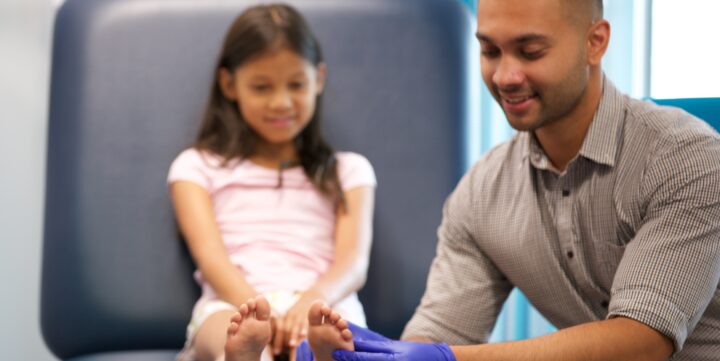Plantar Warts: An overview and guide to modern treatment
September 4, 2023
What is verruca pedis?
Whether you know them as verruca pedis, plantar verruca or simply plantar warts, this condition poses a conundrum for both patients and healthcare providers. Often emerging on the weight-bearing parts of our feet, these warts are not only a cosmetic concern but can also cause significant discomfort.
While plantar warts have distinct characteristics, they can easily be mistaken for corns or calluses to the naked eye. Dermatoscopy is a useful tool in differentiating them. On close inspection, plantar warts showcase hyperkeratosis (callus) or thickening of the skin at the surface. The lesion may also present with a deep and distinct ring around the nucleus, whilst red to brown lines or dots, indicative of broken capillaries, are common features at the centre. Warts are differentiated from corns (heloma millae) by an absence of pain on palpation but a presence of pain upon squeezing. With light debridement of the overlying hyperkeratosis, the verruca will bleed (pin-point bleeds) as it is a highly vascularised lesion. Moreover, a collection of adjacent verrucae can come together to form what is termed “mosaic warts.”
Causes of plantar warts
The root cause of these warts is the human papillomavirus (HPV). Out of its numerous strains, it’s primarily the HPV-1, 4, 27, and 57 strains that lead to the formation of plantar warts. Children and adolescents are particularly susceptible, given the high prevalence of warts in this demographic. While these warts are benign in most cases, there’s a need to be vigilant. Immunosuppressed individuals, for instance, face a risk of these warts transforming into malignant forms such as squamous cell carcinoma or plantar verrucous carcinoma.
Understanding HPV transmission is crucial in curbing its spread. The virus can lay dormant for extended periods before manifesting as a wart. It’s easily transmittable through skin-to-skin contact or shared surfaces, making public areas like swimming pools or shared bathrooms potential hotspots. Self-inoculation is another concern. Scratching or picking at a wart can lead to its spread to other parts of the body. Even clinical tools like dermatoscopes can retain the virus, emphasising the importance of sterilisation. Simple measures, such as wearing footwear at home or in school and covering warts with tape before accessing communal areas, can act as vital preventive steps.
There is some consensus amongst the podiatry community that plantar warts may also arise as a result of lowered immunity or chronic illness. It is therefore worth considering the broader holistic factors which may contribute to recurrence of plantar warts or the inability to remove them.
Should you treat a plantar wart?
Interestingly, a majority of plantar warts resolve on their own, with estimates suggesting that up to 80% disappear without any intervention within a span of two years. However, the discomfort they bring, both physically and emotionally, often leads patients to seek treatment. They can lead to physical discomfort, secondary infection or rise in lesions, as well as changes to foot posture and gait (with flow on biomechanical effects). Given their location in weight-bearing areas, they can cause pain when walking or standing, which can lead to a change in foot posture and gait over time. Scratching or attempting to remove a wart can lead to bacterial infections, not to mention the spread of lesions to other parts of the foot or body.
Tradition treatments: Cryotherapy & Salicylic Acid
A traditional approach, cryotherapy, is the act of freezing the warts. For years, cryotherapy with evaporating liquid nitrogen has been the therapy of choice to treat warts because of its clinical performance and the relatively minor and temporary adverse effects, not to mention its accessibility in a clinical space. But its efficacy remains under scrutiny. Many clinical trials have reported low success rates, coupled with significant pain and blistering.
Cryotherapy involves the thorough freezing followed by thawing of the wart-infected tissue. A prevailing hypothesis regarding its working mechanism suggests that it triggers localised tissue death through the freeze-thaw sequence. This, in turn, sparks an immune-inflammatory response, leading the wart towards healing and eventual disappearance. Given that HPV infections reside in the deeper layers of the epidermis, it’s crucial that the chilling effect penetrates these layers effectively. Factors that impact this energy transmission include the starting freeze temperature, the application method, the length of the treatment, and the specific location of the wart.
Salicylic acid is widely recognized as the first line of treatment, and plays a dual role. It debrides the skin and aids in the elimination of warts. Its efficacy is backed by a Cochrane review that highlighted a 29% increase in cure rate compared to placebo over a 12 to 13-week period. However, practitioners should remain cautious as it can cause irritation, especially in sensitive areas, and requires good patient compliance to achieve results.
We can learn a lot from the podiatric industry and their approach to warts, many of whom warn that at-home salicylic acid treatments often do more harm than good. With poor control over the application of the treatment, patients can often present back with serious dermal burns of the surrounding and adjacent skin. With application in clinic, practitioners can apply a higher degree of accuracy to the application, not to mention the access to higher doses of salicylic acid (reducing the number of applications and subsequent trauma to the tissue needed). Podiatrists often use felt, sports tape of petroleum jelly to protect the surrounding skin and control the application of the acid onto the patient’s foot. Afterall, we are often talking about application of a highly acidic substance on the plantar aspect of the foot, a foot which is bound to walk and apply a full body of weight to this area.
The rise of silver nitrate
There are a range of other topicals, and agents such as silver nitrate and fluorouracil (5-FU) that have demonstrated varying degrees of success. Silver nitrate’s utility is marred by potential side effects like skin staining (although superficial and lasting 1-2 weeks) and chemical burns. Fluorouracil, while potent with high eradication rates, can cause adverse effects like pain and blistering.
Silver nitrate sticks come in the form of wooden sticks with 75% silver nitrate and 25% potassium nitrate on the tip. The chemical compounds are activated with moisture either through the application of water or by contacting a moist membrane or wound. Once applied, the site does not need to be kept dry or contained, making for easier compliance especially in children or teenage patients. The tissue will progressively turn dark and exfoliate naturally, leading to a reduction in verruca tissue and an alert to the immune system. This method is not known for any painful application experience, and so can play a vital role in paediatric treatment.
The effectiveness of this method is determined by a few factors, including how close to the lesion tissue it is applied (i.e. after adequate debridement of the overlying callus), how many application treatments are had over the course of the treatment period, and how long-standing/extensive the lesion is.
Surgical removal an option
When other treatments don’t yield results, surgical removal might be contemplated. However, it comes with its own set of challenges, including the risk of scarring, infection, and post-operative pain.
Microwave therapy with astonishing results
Microwave therapy, using the ‘Swift’ device, is a promising intervention for plantar warts. The Swift technique employs non-ionizing microwave radiation, heating HPV-infected tissue, damaging keratinocytes, and bolstering adaptive immunity. Unlike traditional cold treatments, applying microwaves heats the HPV-infected tissue, not only damaging the keratinocytes but also enhancing adaptive immunity. It offers precise targeting, minimal pain, no scarring, and lacks post-treatment dressing requirements. Unlike some methods, it doesn’t produce vapour or smoke, reducing airborne viral risks.
A study from an Auckland podiatry clinic reported an 83.3% wart resolution rate using Swift—outperforming traditional treatments like cryotherapy. Younger patients benefited the most, though some reported brief pain during sessions. Further large-scale studies are advised to confirm these results.
Conclusion
Plantar warts, while often benign, can pose significant challenges. Their link to HPV, coupled with their potential to spread, underscores the need for prevention and timely intervention. Consider collaboration with podiatry or dermatology for an extended range of treatment options and wound management for the complex patient. As research continues, our understanding and management strategies for plantar warts will only evolve, promising better outcomes for affected individuals.
Bruggink SC, de Koning MNC, Gussekloo J, et al. Cutaneous wart-associated HPV types: prevalence and relation with patient characteristics. J Clin Virol 2012;55:250–5.
Coates CM, Boehm AP, Leonheart EE, et al. Malignant transformation of plantar verrucae. Adv Skin Wound Care 2006;19:384–5.
Hagon, W., Hagon, J., Noble, G. et al. Microwave therapy for the treatment of plantar warts. J Foot Ankle Res 16, 37 (2023). https://doi.org/10.1186/s13047-023-00638-8
Walczuk I, Eertmans F, Rossel B, Cegielska A, Stockfleth E, Antunes A, Adriaens E. Efficacy and Safety of Three Cryotherapy Devices for Wart Treatment: A Randomized, Controlled, Investigator-Blinded, Comparative Study. Dermatol Ther (Heidelb). 2018 Jun;8(2):203-216. doi: 10.1007/s13555-017-0210-5. Epub 2017 Dec 6. PMID: 29214505; PMCID: PMC6002322.












